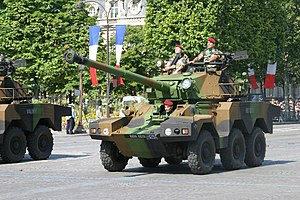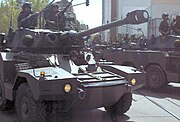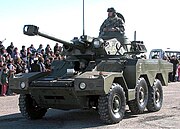| ERC 90 Sagaie | |
|---|---|
 | |
| Place of origin |
|
| Service history | |
| Wars | |
| Specifications | |
| Mass | 8.3 tonnes |
| Length | 7.7 metres (25 ft) |
| Width | 2.50 metres (8.2 ft) |
| Height | 2.25 metres (7.4 ft) |
| Crew | 3 |
|
| |
| Armour | 10 mm |
Main armament | 90 mm cannon |
Secondary armament | 2× 7.62 mm machine gun |
| Engine |
Peugeot V-6 Petrol 155 hp at 5,250 rpm |
Operational range | 730 kilometres (450 mi) |
| Maximum speed | 90 km/h |
The Panhard ERC 90 (Engin de Reconnaissance à Canon de 90 mm) is a French six-wheeled armoured all terrain vehicle which is highly mobile and amphibious with an option of being NBC-proof. While various models were tested, only two versions of the ERC were developed and produced: the Lynx and the Sagaie. The only difference between the two versions being the type of main cannon mounted in the turret. Sagaie is French for Assegai, a type of African Spear.
Background[]
The Sagaie is originally a private-export project, the ERC 90 wheeled armoured vehicles were developed by Panhard in the last half of the 1970s as successor to its highly successful four wheel AML and M3 armoured vehicles.
Design[]
The ERC and VCR are a family of six wheel armoured reconnaissance vehicles, the ERC being the cannon armed turret model and the VCR being the armoured personnel carrier version. ERC is the French abbreviation of term Engin de Reconnaissance Canon, or Gun-armed Reconnaissance Vehicle. The ERC shares many components of the VCR vehicles. Two main versions of the ERC were developed: the first model being the ERC F1 90 Lynx followed by the ERC F4 90 Sagaie. The Lynx appearing about 1977 and the Sagaie following approximately two years later in 1979. The Lynx was developed primarily as an armoured reconnaissance vehicle. The Sagaie was also a primary armoured reconnaissance vehicle, with the added secondary role of tank-destroyer. Panhard purposed in 1977 both the ERC and the VCR vehicles to the French Army, but lost the largest contract to a four wheeled armoured vehicle offered by Saviem with its VAB and the cannon armed reconnaissance vehicle requirement to a vehicle offered by GIAT the AMX 10 RC and also lost a much smaller order for the French Mobile Gendarmerie to the Saviem VBC-90. But Panhard later found success for both VRC and ERC as a private project in the world export market, and later with the ERC version with orders from the French Army, which had at first rejected the Panhard contender.[1][2]
Production history[]

ERC Sagaie loading into a Transall C-160.
The first production orders for the ERC 90 F1 Lynx, was an order for 36 in October 1979 from Argentina, for employment by its Marines to patrol the long border between Argentina and Chile. The second large order was from Mexico for 42 Lynxs in early 1981. Both countries ordered the ERC Lynx version, because of its ability to elevate or depress its 90mm cannon over a wider range for operations in steep mountain terrain.
Further export orders followed. Both nations also appreciated the all terrain mobility of the ERC 90 F1 Lynx which is enhanced by the capability to raise or lower the central pair of wheels depending on terrain condition, especially in sandy or muddy ground.[3] All versions of the ERC are also equipped with two hydrojets behind the rear wheels and require no preparation for amphibious operations.[2]
ERC 90 F4 Sagaie[]

ERC Sagaie of the 1 RHP in 2003
Shortly after the ERC 90 F1 Lynx had been built for export, Panhard recognised the need for a cost effective light armoured vehicle that could defeat more modern main battle tanks (MBT), like the Russian T-72 which was being exported to many nations. They developed a turret in which they mounted the long barrel F4 90 mm smooth bore cannon developed by the French-government defence firm GIAT and designated the vehicle the ERC 90 F4 Sagaie. Unlike the Lynx version which could only fire medium velocity HEAT rounds in the anti-tank role, which lacked the penetration to defeat the more modern MBTs, the Sagaie could fire Armour Piercing Fin Stabilised Discard Sabot rounds (APFSDS) at a much higher velocity than the Lynx's F1 90mm smooth bore cannon and which at 2000 metres GIAT and Panhard both claimed would enable the Sagaie to defeat the heavy armour threat of the 1980s. For a while, GIAT engineers, were vexed with finding a suitable muzzle brake for the Sagaie which would not interferer with the firing of APFSDS rounds, but finally found a suitable solution with the fitting of a muzzle brake design from the older AMX-13 light tank.[2]
The Ivory Coast was the first export customer, ordering five Sagaies to replace its outdated AMX-13 light tanks. At this time period, the French Army was organising the Fast Deployment Force (FDF) for overseas military missions. Mainly in Africa or the Middle East. The main core of the FDF would be French Army's 9th Marine Infantry Division and the French Army's 11th Parachute Division.[4] To enable the new FDF to be "more muscular" a new unit was activated, the 31st Heavy Half Brigade (31 DBL) of two regiments. One regiment was to be armed with armoured vehicles mounting the HOT wire-guided missile and the other a cannon-armed light armoured vehicle that could provide both reconnaissance and a limited tank-killing role.
The French Army had at first planned on equipping the later regiment with the AMX-10RC, but were told that this vehicle was not suitable for transport by the French Air Force Transall C-160 or its allies' Hercules C-130 aircraft due to size and weight issues. In addition, most of the bridges in Africa had only a 6 to 8 ton load capacity. So instead of the larger AMX-10RC, which was already in service with the French Army, the French Army Staff took the surprise step in December 1980 of ordering the Panhard ERC 90 F4 Sagaie for the future FDF.[2] And to date the Sagaie has proved very useful for the French Army in its African bases and even in urban conditions during the Siege of Sarajevo. The last known combat use of the Sagaie was with French Forces stationed in the Ivory Coast on a peace keeping mission between two rival factions. In 1982 the ERC 90 F1 Lynxs of Argentina Marines saw combat in the Falkland Islands in the defence of Port Stanley.
ERC-90 Sagaie 2 (twin-engine)[]
The major weakness of the Sagaie is the low power-to-weight ratio. The Sagaie 2 is an ERC extended with two 4-cylinder Peugeot diesel 98 hp engines; the same engine used on the LAV (Light Armoured Vehicle). Six were ordered by Gabon. A prototype was built as a private venture equipped with two PRV V6 engines, but none was ordered.
Variants[]

French ERC 90 Sagaie of the reconnaissance squadron of the 13th half-brigade of the Foreign Legion near Djibouti in 2005
- EMC 91: Fire support version armed with 81mm mortar in an Hispano-Suiza EMC turret.
- ERC 20: Anti-aircraft version with 2× 20 mm autocannons.
- ERC 60-20: Fitted with Hispano-Suiza 60-20 Serval turret armed with a 60 mm mortar and a 20 mm autocannon.
- ERC 90 (Diesel): Fitted with a diesel engine.
- ERC 90 F1 Lynx: Fitted with the Hispano-Suiza Lynx 90 turret as fitted to the Panhard AML.
- ERC 90 F4 Sagaie: Fitted with GIAT TS 90 turret with long barrel high velocity cannon that can fire APDS-FS anti-tank rounds.
- ERC 90 Sagaie 2: Slightly larger version fitted with twin engines and improved turret.
- VCR: APC based on ERC.
User countries[]

Mexican Army ERC 90 F1 Lynx during the Independence day Parade.
 Argentina (Argentine Marine Corps) - 14
Argentina (Argentine Marine Corps) - 14 Chad - 4
Chad - 4 Côte d'Ivoire - 7
Côte d'Ivoire - 7 Ecuador - 10[citation needed]
Ecuador - 10[citation needed]France - 192
 Gabon - 14
Gabon - 14 Mexico - 120
Mexico - 120 Nigeria - 46
Nigeria - 46
Characteristics[]
| ERC 90 Sagaie-Lynx | |
|
| |
|
|

Argentine Marines ERC 90 F1 Lynx Recon. Vehicle
- Armament: 1 x 90 mm, 1 x 7.62 mm coaxial MG, 1 x 7.62 mm AA MG AA (optional), 2 x 2 smoke grenade dischargers
- Ammunition: 20 x 90 mm, 2,000 x 7.62 mm
- Armour: maximum 10 mm steel
- Crew: 3
- Weight:: 8,100 kg
- Length: 5.10 m hull, 7.69 m overall
- Width: 2.49 m
- Height: 2.25
- Wheelbase: 1.63 + 1.22 m
- Engine: Peugeot V-6 petrol, 155 hp (116 kW) at 5,250 rpm
- Maximum speed: 95 km/h
- Fuel capacity: 242 L
- Range: 700 km
- Fording: Amphibious
- Water speed: 4.5 km/h wheels, 9.5 km/h hydrojets
- Ground clearance: 0.34 m
- Vertical obstacle: 0.8 m
- Trench: 1.1 m
- Gradient: 60%
- Side Slope: 30%
- NBC system: Optional
- Night vision: Optional (passive)
References[]
- Notes
- ↑ Jane's AFV Recognition Handbook, author Christopher Foss
- ↑ 2.0 2.1 2.2 2.3 Light Armored Vehicles for French Rapid Deployment Force, by R. Furlong, International Defense Review May 1981
- ↑ the French Army's Sagaies now have their middle set of wheels fixed in the down position
- ↑ In the French army the Marine units are the old Colonial Infantry, Troupes coloniales, renamed Troupes de marine in 1961, and not amphibious units.
External links[]
| Wikimedia Commons has media related to ERC-90 Sagaie. |
- Video links
- Panhard company promotional video of the ERC 90 Sagaie on YouTube
- Sagaie in action in CHAD on Youtube by Panhard 2008.
| |||||||||||
| |||||||||||
The original article can be found at ERC 90 Sagaie and the edit history here.